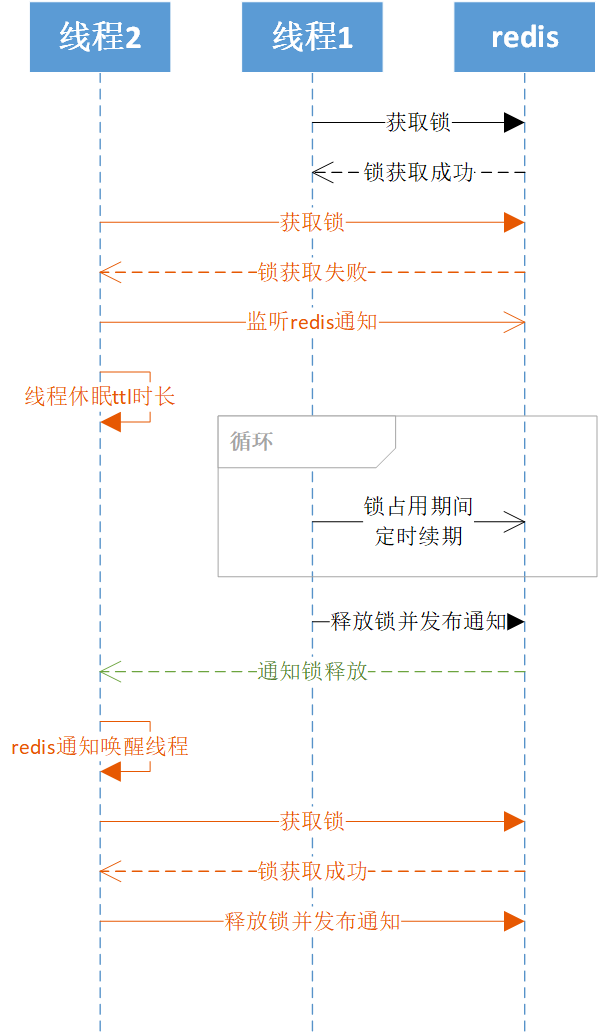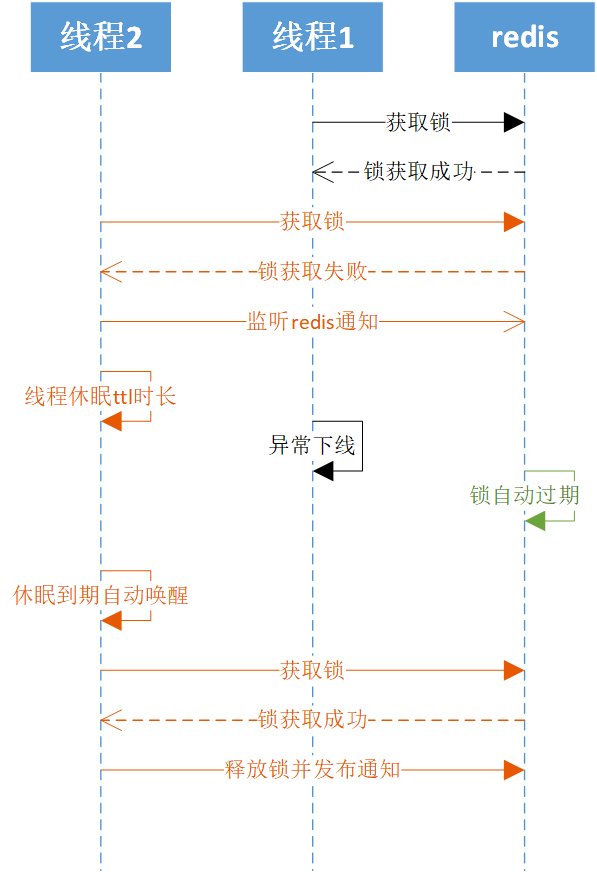简单使用 1 2 3 4 5 6 7 8 9 10 String key = "key-lock" ; RLock lock = redisson.getLock(key); lock.lock(); try { } catch (Exception e){ log.error(e.getMessage(), e); } finally { lock.unlock(); }
1 2 3 4 5 6 7 8 9 10 11 12 13 14 String key = "key-tryLock" ; long maxWaitTime = 3_000 ;RLock lock = redisson.getLock(key); if (lock.tryLock(maxWaitTime, TimeUnit.MILLISECONDS)){ try { } catch (Exception e){ log.error(e.getMessage(), e); } finally { lock.unlock(); } } else { log.debug("redis锁竞争失败" ); }
流程图 多个线程节点锁竞争的正常流程如下图:
多个线程节点锁竞争,并出现节点下线的异常流程如下图:
源码解析 RedissonLock是可重入锁,使用redis的hash结构作为锁的标识存储,锁的名称作为hash的key,UUID + 线程ID作为hash的field,锁被重入的次数作为hash的value。如图所示:
1 2 3 4 5 6 7 8 9 10 11 12 13 14 15 16 17 18 19 20 21 22 23 24 25 26 27 28 29 30 31 32 33 34 35 36 37 38 39 40 41 42 43 44 private void lock (long leaseTime, TimeUnit unit, boolean interruptibly) throws InterruptedException long threadId = Thread.currentThread().getId(); Long ttl = tryAcquire(leaseTime, unit, threadId); if (ttl == null ) { return ; } RFuture<RedissonLockEntry> future = subscribe(threadId); commandExecutor.syncSubscription(future); try { while (true ) { ttl = tryAcquire(leaseTime, unit, threadId); if (ttl == null ) { break ; } if (ttl >= 0 ) { try { getEntry(threadId).getLatch().tryAcquire(ttl, TimeUnit.MILLISECONDS); } catch (InterruptedException e) { if (interruptibly) { throw e; } getEntry(threadId).getLatch().tryAcquire(ttl, TimeUnit.MILLISECONDS); } } else { if (interruptibly) { getEntry(threadId).getLatch().acquire(); } else { getEntry(threadId).getLatch().acquireUninterruptibly(); } } } } finally { unsubscribe(future, threadId); } }
1 2 3 4 5 6 7 8 9 10 11 12 13 14 15 16 17 18 19 20 21 22 23 24 25 26 27 28 29 30 31 32 33 34 35 36 37 38 39 40 41 42 43 44 45 46 47 48 49 50 51 52 53 54 55 56 57 58 59 60 61 62 63 64 65 66 67 public boolean tryLock (long waitTime, long leaseTime, TimeUnit unit) throws InterruptedException long time = unit.toMillis(waitTime); long current = System.currentTimeMillis(); long threadId = Thread.currentThread().getId(); Long ttl = tryAcquire(leaseTime, unit, threadId); if (ttl == null ) { return true ; } time -= System.currentTimeMillis() - current; if (time <= 0 ) { acquireFailed(threadId); return false ; } current = System.currentTimeMillis(); RFuture<RedissonLockEntry> subscribeFuture = subscribe(threadId); if (!await(subscribeFuture, time, TimeUnit.MILLISECONDS)) { if (!subscribeFuture.cancel(false )) { subscribeFuture.onComplete((res, e) -> { if (e == null ) { unsubscribe(subscribeFuture, threadId); } }); } acquireFailed(threadId); return false ; } try { time -= System.currentTimeMillis() - current; if (time <= 0 ) { acquireFailed(threadId); return false ; } while (true ) { long currentTime = System.currentTimeMillis(); ttl = tryAcquire(leaseTime, unit, threadId); if (ttl == null ) { return true ; } time -= System.currentTimeMillis() - currentTime; if (time <= 0 ) { acquireFailed(threadId); return false ; } currentTime = System.currentTimeMillis(); if (ttl >= 0 && ttl < time) { getEntry(threadId).getLatch().tryAcquire(ttl, TimeUnit.MILLISECONDS); } else { getEntry(threadId).getLatch().tryAcquire(time, TimeUnit.MILLISECONDS); } time -= System.currentTimeMillis() - currentTime; if (time <= 0 ) { acquireFailed(threadId); return false ; } } } finally { unsubscribe(subscribeFuture, threadId); } }
RedissonLock实现的是可重入锁,通过redis的hash结构实现,而非加单的set nx ex。为了实现原子性的复杂的加锁逻辑,而通过lua脚本实现。获取锁会有如下三种状态:
锁未被任何线程占用,则锁获取成功,返回null
锁被当前线程占用,则锁获取成功并进行锁的重入,对锁的重入计数+1,返回null
锁被其他线程占用,则锁获取失败,返回该锁的自动过期时间ttl
1 2 3 4 5 6 7 8 9 10 11 12 13 14 15 16 17 <T> RFuture<T> tryLockInnerAsync (long leaseTime, TimeUnit unit, long threadId, RedisStrictCommand<T> command) { internalLockLeaseTime = unit.toMillis(leaseTime); return commandExecutor.evalWriteAsync(getName(), LongCodec.INSTANCE, command, "if (redis.call('exists', KEYS[1]) == 0) then " + "redis.call('hset', KEYS[1], ARGV[2], 1); " + "redis.call('pexpire', KEYS[1], ARGV[1]); " + "return nil; " + "end; " + "if (redis.call('hexists', KEYS[1], ARGV[2]) == 1) then " + "redis.call('hincrby', KEYS[1], ARGV[2], 1); " + "redis.call('pexpire', KEYS[1], ARGV[1]); " + "return nil; " + "end; " + "return redis.call('pttl', KEYS[1]);" , Collections.<Object>singletonList(getName()), internalLockLeaseTime, getLockName(threadId)); }
当锁因为被其他线程占用而 使用redis的发布订阅pub/sub功能,通过监听锁的释放通知(在其他线程通过RedissonLock释放锁时,会通过发布订阅pub/sub功能发起通知),等待锁被其他线程释放。通过如此的线程唤醒而非自旋的操作,提高了锁的效率。
1 2 3 4 5 6 7 8 9 10 11 12 13 14 15 16 17 18 19 20 21 22 23 24 25 26 27 28 29 30 31 32 33 34 35 36 37 38 39 40 41 42 public RFuture<E> subscribe (String entryName, String channelName) AtomicReference<Runnable> listenerHolder = new AtomicReference<Runnable>(); AsyncSemaphore semaphore = service.getSemaphore(new ChannelName(channelName)); RPromise<E> newPromise = new RedissonPromise<E>() { @Override public boolean cancel (boolean mayInterruptIfRunning) return semaphore.remove(listenerHolder.get()); } }; Runnable listener = new Runnable() { @Override public void run () E entry = entries.get(entryName); if (entry != null ) { entry.aquire(); semaphore.release(); entry.getPromise().onComplete(new TransferListener<E>(newPromise)); return ; } E value = createEntry(newPromise); value.aquire(); E oldValue = entries.putIfAbsent(entryName, value); if (oldValue != null ) { oldValue.aquire(); semaphore.release(); oldValue.getPromise().onComplete(new TransferListener<E>(newPromise)); return ; } RedisPubSubListener<Object> listener = createListener(channelName, value); service.subscribe(LongCodec.INSTANCE, channelName, semaphore, listener); } }; semaphore.acquire(listener); listenerHolder.set(listener); return newPromise; }
由于是可重入锁则需要在释放锁的时候做订阅通知,因此释放锁的操作同样是lua脚本实现。锁的释放会有如下三个状态:
等待释放的锁不存在或者不是当前线程持有,返回null
等待释放的锁被当前线程持有,且该锁当前被重入多次,则锁的重入计数-1,返回0
等待释放的锁被当前线程持有,且该锁当前未被重入,则锁的删除并发布该锁释放的订阅通知,返回1
1 2 3 4 5 6 7 8 9 10 11 12 13 14 15 16 17 18 protected RFuture<Boolean> unlockInnerAsync (long threadId) return commandExecutor.evalWriteAsync(getName(), LongCodec.INSTANCE, RedisCommands.EVAL_BOOLEAN, "if (redis.call('hexists', KEYS[1], ARGV[3]) == 0) then " + "return nil;" + "end; " + "local counter = redis.call('hincrby', KEYS[1], ARGV[3], -1); " + "if (counter > 0) then " + "redis.call('pexpire', KEYS[1], ARGV[2]); " + "return 0; " + "else " + "redis.call('del', KEYS[1]); " + "redis.call('publish', KEYS[2], ARGV[1]); " + "return 1; " + "end; " + "return nil;" , Arrays.<Object>asList(getName(), getChannelName()), LockPubSub.UNLOCK_MESSAGE, internalLockLeaseTime, getLockName(threadId)); }
Watchdog RedissonLock为了避免应用获取锁后宕机,因为没人来释放锁而导致死锁情况的出现,默认每次锁的占用只有30秒的时间(org.redisson.config.Config#lockWatchdogTimeout = 30 * 1000)。于是便有了Watchdog设计,由独立的线程定时给未释放的锁续期,默认锁有效期的三分之一的时长即每10秒给锁自动续期。
1 2 3 4 5 6 7 8 9 10 11 12 13 14 15 16 17 18 19 20 21 22 23 24 25 26 27 28 29 30 31 32 33 34 35 36 37 38 39 40 41 42 43 44 45 46 private void renewExpiration () ExpirationEntry ee = EXPIRATION_RENEWAL_MAP.get(getEntryName()); if (ee == null ) { return ; } Timeout task = commandExecutor.getConnectionManager().newTimeout(new TimerTask() { @Override public void run (Timeout timeout) throws Exception ExpirationEntry ent = EXPIRATION_RENEWAL_MAP.get(getEntryName()); if (ent == null ) { return ; } Long threadId = ent.getFirstThreadId(); if (threadId == null ) { return ; } RFuture<Boolean> future = renewExpirationAsync(threadId); future.onComplete((res, e) -> { if (e != null ) { log.error("Can't update lock " + getName() + " expiration" , e); return ; } if (res) { renewExpiration(); } }); } }, internalLockLeaseTime / 3 , TimeUnit.MILLISECONDS); ee.setTimeout(task); } protected RFuture<Boolean> renewExpirationAsync (long threadId) return commandExecutor.evalWriteAsync(getName(), LongCodec.INSTANCE, RedisCommands.EVAL_BOOLEAN, "if (redis.call('hexists', KEYS[1], ARGV[2]) == 1) then " + "redis.call('pexpire', KEYS[1], ARGV[1]); " + "return 1; " + "end; " + "return 0;" , Collections.<Object>singletonList(getName()), internalLockLeaseTime, getLockName(threadId)); }


